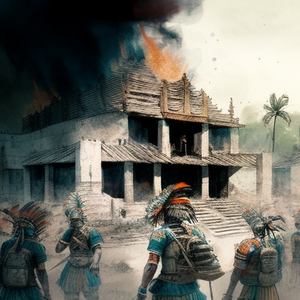Crisis of the 13th Century
| Crisis of the 13th Century | ||||||||
|---|---|---|---|---|---|---|---|---|
 The Bujhisa of Daktuva burns as several bakṣa look on. | ||||||||
| ||||||||
| Belligerents | ||||||||
| Imperial Clique | Eastern Clique | Northern Clique | ||||||
| Commanders and leaders | ||||||||
| Ẓḍama Yansa | Toḍẓa Harmasa | Hava Khihanhe | ||||||
The Crisis of the 13th Century, also known as the Cananganamese Imperial Succession Crisis or the Anarchy (Cananganamese: Ghakṭhḗ /gʱɐ̀kʈʰíː/) in Cananganam, were a series of conflicts and disasters that struck the Cananganamese Empire during the late 13th century of which the effects were felt well into the early 15th century. The period was recorded of being of significant strife, entire bodies of societal structures being either up-ended or totally destroyed, and a series of military campaigns would which eventually pave the path for the formulation of the distinct nations of Cananganam, Mujansa, Sunha, and Haboya.
Fracture of the Imperial Succession
As was tradition within the Lunukist system of governance, the imperial succession held significant hold over the Cananganamese Empire. The emperor was believed to be a demi-godlike figure in Canamic society, whose succession was determined by religious council upon the death of the 'vessel' of the emperor, whereupon the next vessel of the emperor would be found amongst newborns birthed around the same time. From this, a suitable candidate would be selected and the child raised to be the next emperor, though most of the time these figures would generally be puppets to more powerful bhecho, warlord regents. As would happen, a meeting was to be held between then-emperor Tcokṣa, and then-bhecho Areṭṣa Keplasa. While the contents of the meeting are unknown, it's speculated an emergency over an earthquake several hours before caused the emperor and the bhecho to discuss how to handle the situation of some fires that broke out in the city of Daktuva. During this meeting, a tsunami had swept much of the coast, destroying much of the port and taking with a large section of the imperial court including both the emperor and the bhecho.
With the loss of much of the empire's entire upper hierarchy at once, the succession of the emperor was in jeopardy and distrust between the nobles resulted in a general belief in that the apocalypse had come across the world due to the sudden disappearance of the emperor. Several peasant uprisings began in the countryside as soon as word of the news spread. Three factions began to form over the matter of the imperial succession; the Imperial clique under Ẓḍama Yansa, the Eastern clique under Toḍẓa Harmasa, and the Northern clique under Hava Khihanhe. Initially, talks were successful in preventing an outright civil war, as it was believed among the peasants that Dustra, the Sun God, would unleash a torent of spirit demons upon the world. When much of the hysteria calmed down, the hope was that renewed talks regarding the emperor would settle the disputes. A council was to be convened in early 1265, however this did not come to fruition as disputes over who held the role of bhecho swept the aristocracy. The shaky triumvirate had begun to fall apart by the end of 1265, with some skirmishes occurring Munasa, dangerously close to the capitol. When Ẓḍama Yansa requested the Northern clique's leader, Hava Khihanhe, take responsibility, the army under Hava began to march onto the imperial capitol of Daktuva.
Burning of Daktuva
Ẓḍama Yansa, fearing the news of a 15,000 man army marching on the mostly undefended capitol, fled with his closest advisors from the city. Hava Khihanhe with his men occupied the city on February 17, 1266. Initially, the plan to hold the city was made as a means to legitimize his succession, however when a rumor that the original bhecho, Areṭṣa Keplasa, was still alive and returning to Cananganam with an army of 50,000 spread, Hava ordered his troops to dismantle Daktuva's walls before looting and burning the capitol. With priceless artifacts and the majority of the empire's libraries and monasteries destroyed or ransacked, he and his men left to head northwards to his territories within the province of Haboya.
The destruction of the city is responsible for most records of the pre-crisis period being almost entirely lost aside from several minor libraries that managed to avoid the ransacking. The capitol was almost entirely abandoned in the following year as the destruction and looting spread throughout the province. Ẓḍama Yansa would re-occupy the remains of the capitol in 1267 following the restructuring of his forces, but they would not hold the capitol for long as they would be pushed out in early 1270 by the local garrison, bribed by the Eastern clique to do so handing the city squarely to Toḍẓa Harmasa and his troops who would occupy the city for the next 8 years.
Plague of 1271
Starting out in 1271, a plague broke out following the failed harvests of the past two years. The failed harvests and the increasing conflict led to increased population densities in the cities, bringing with the sudden mass movement of people the plague of 1271. This plague managed to wipe out nearly 15-45% of the population of the empire over the next 15 years before it would eventually burn out. The effects resulted in the total collapse of what little was left of the imperial economic structure, and combined with brain drain, many engineering marvels were simply left ineffectively used and under-maintainanced.